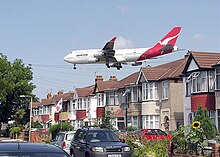(Airplanes--one of many sources of anthropogenic noise pollution. Image courtesy of Wikipedia.)
To date, there are three (non-mutually exclusive) hypotheses about the mechanisms responsible for these patterns. First, the presence of noise may interfere with the mate choice process by obscuring male vocalizations; this could cause females to feel insecure about the quality of their mates, and therefore invest less time and energy in reproduction. Second, noisy territories may be seen as lower quality and therefore contain the less experienced, younger, and/or poorer quality individuals who were not able to claim and defend better habitats. Third, noise may impair chick development by increasing stress levels in chicks and/or obscuring their begging calls and causing them to receive less food from their parents.
Distinguishing among these hypotheses requires a study setup permitting long-term data collection and the ability to identify individuals. Happily, these are two characteristics of an ongoing study on Lundy Island, located in the Atlantic Ocean/Bristol Channel off the coast of North Devon, UK. The island's electricity is supplied by noisy generators that run for 6 hours each day; birds nesting in the immediate vicinity of the generators are exposed to noise up to 68 dB in volume, while those nesting in the woods, or on the other side of nearby barns, experience "natural" levels of noise. By reviewing 8 years of breeding data collected for house sparrows nesting across this noise gradient, an international team of collaborators has been able to explore not only how noise impacted breeding success, but why.
(Lundy Island, UK. Image courtesy of English Heritage.)
The scientists used 2 techniques that add an extra layer of uniqueness to their study. First, they randomly selected a subset of chicks to "cross-foster" each year. In other words, chicks that were born in noisy habitats would be swapped with chicks born in quiet habitats (and vice versa), then raised by their foster parents in their new acoustic environment. This helps eliminate the possibility that results are driven by genetic differences between noisy-habitat and quiet-habitat birds, as opposed to the environments themselves. Second, the researchers have been giving the birds unique combinations of number and color bands. This allows them to follow individuals re-nesting within a single season and from one season to the next. Since birds often moved from one type of habitat to another, and since birds in the noisy habitats experienced periodic increases in environmental noise when generator fans kicked on, this means that the scientists could look for both among- and within-individual variations in breeding behavior and reproductive success.
The major finding of the study was that survivorship was significantly lower for chicks raised in noisy environments. Specifically, these juveniles were less likely to survive between hatching and fledging, as well as between fledging and the next breeding season. This is probably at least partly caused by the fact that chicks that were reared in noisy areas had significantly lower body mass at 12 days (just before fledging). This, in turn, was likely driven by lower brood-provisioning rates among noisy-habitat females--something that was seen over both the long term (between breeding attempts at boxes in different types of habitat) and over the short term (between quieter and louder periods within the noisy habitat).
(House sparrow male. Image courtesy of A.W. Birder.)
Other reproductive parameters--including number of eggs, number of chicks, lay date, and number and length of incubation visits--were similar between the two types of site. Likewise, house sparrows settled in both noisy and quiet sites at the same rate, indicating that the former are probably not perceived as being "sub-par." In fact, males in noisy areas were significantly older--a characteristic that is usually associated with dominance and, therefore, occupancy of preferable, higher-quality territories.
Cumulatively, these results provide strong support for the "impaired chick development" hypothesis. At this point, the authors are not able to determine exactly what is impairing chick development, but a likely candidate is the inadequate provisioning rate of sparrow mothers living in noisy habitats. This bad parenting probably doesn't stem from willful neglect, but rather the mothers' inability to hear the begging calls of their offspring. Fathers--in both this and other house sparrow populations--tend to feed their chicks at a constant rate regardless of environmental conditions; thus, it is up to mothers to pick up the slack. Noise seems to interfere with this process, leaving the chicks to go hungry.
(Female house sparrow feeding nestlings. Image courtesy of Dr. Adam Porter.)
In addition to providing interesting and useful information for avian conservation efforts in general, this study may also have produced some clues vital to solving the mystery of why house sparrows have been declining over much of their native range. Although they are "thought to be well adapted to living in close association with humans, where chronic background noise is pervasive," the current results suggest that even the most human-tolerant of species may have a threshold beyond which it cannot cope with anthropogenic disturbance. Managers may be able to use this information to create sparrow-friendly habitats where the birds can breed in peace--and quiet.
---
Schroeder, J., Nakagawa, S., Cleasby, I.R., and Burke, T. 2012. Passerine birds breeding under chronic noise experience reduced fitness. PLoS ONE 7(7):e39200.




No comments:
Post a Comment